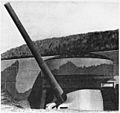Joint Expeditionary Base Fort Story facts for kids
Quick facts for kids Fort Story |
|
|---|---|
| Part of Joint Expeditionary Base Little Creek-Fort Story | |
| Virginia Beach, Virginia | |

Command Logo
|
|
| Coordinates | 36°55′38″N 76°00′59″W / 36.9273°N 76.0164°W |
| Type | Army Base |
| Site information | |
| Controlled by | |
| Site history | |
| In use | 1914–present |
Fort Story is a special military base in Virginia Beach, Virginia. It's part of a bigger base called Joint Expeditionary Base Little Creek–Fort Story, which is run by the United States Navy. Fort Story is located at Cape Henry, right where the Chesapeake Bay meets the Atlantic Ocean.
This base is unique because it has many different natural features. You can find sand dunes, beaches, and even forests here. It's a perfect spot for the U.S. Army to practice special water-based operations. They also train for moving supplies from ships to shore, which is called Logistics-Over-the-Shore (LOTS).
Contents
Exploring Fort Story
Fort Story covers about 1,451 acres (5.9 square kilometers). This area includes sandy paths, cypress swamps, and maritime forests. You'll also see grassy dunes and both soft and hard sand beaches.
The beaches on the western side are wide and gently sloped. They are washed by the calm waters of the Chesapeake Bay. The eastern beaches face the Atlantic Ocean. Here, the water is rougher with bigger waves.
Historic Sites at Fort Story
Fort Story is home to three important historical places. These sites tell stories from a long time ago.
- The Cape Henry Memorial Cross shows where the first Jamestown Settlers landed in 1607. This was a very important moment in American history.
- The Old Cape Henry Light was the first lighthouse built by the U.S. government. It helped guide ships safely into the bay.
- At the Battle of the Virginia Capes Monument, there is a statue of French Admiral François Joseph Paul de Grasse. This statue honors a famous sea battle that happened on September 5, 1781. This battle was key in stopping the British from reaching Yorktown during the American Revolutionary War.
There's also a newer lighthouse at Cape Henry. It was finished in 1881. The U.S. Coast Guard still uses it today to guide ships. A old train station from 1902 has also been restored. The Army now uses it as a place for education.
Fort Story's Past
Fort Story has a rich history as a military base. It has played a role in major wars and changes.
World War I Era
Fort Story became a military base in 1914. The state of Virginia gave the land to the U.S. government. The idea was to build defenses and for other military uses. The base was named after Major General John Patten Story. He was a well-known artillery expert.
During World War I, Fort Story was part of the defenses for the Chesapeake Bay. It worked with other forts like Fort Monroe and Fort Wool. At first, Fort Story had a few rapid-fire guns. These guns were moved from other forts to help protect the coast. After the war, some of these guns were returned or removed.
Between the World Wars
After World War I, Fort Story became quieter. In 1922, powerful 16-inch howitzers were placed at Fort Story. These huge guns could fire shells much farther than older guns. This meant they could stop enemy ships before they got close to the bay. Fort Story was the only place to get these specific howitzers.
In 1924, the base became a Harbor Defense Command. It remained mostly inactive until World War II began. Soldiers from the 12th Coast Artillery Regiment were stationed there. They practiced firing drills in 1928.
World War II Era
Before the United States joined World War II in 1941, Fort Story got more land. After the attack on Pearl Harbor, more guns were added. These included 155mm guns and later, 6-inch guns.
Even bigger 16-inch guns were installed. These were protected by strong concrete shelters called casemates. The howitzers also got shelters to protect them from explosions. These powerful guns, along with others at nearby forts, guarded the entrance to Chesapeake Bay. They were ready to defend against any enemy ships.
In 1944, Fort Story started to change. It became a hospital for soldiers returning from the war. By the time it closed in 1946, the hospital had helped over 13,000 patients.
After World War II
In 1946, Fort Story began a new role: training for amphibious operations. This means training soldiers to move from water to land. The base became a place for the Transportation Corps to teach how to move supplies from ships to shore.
After World War II, many old coast defense guns were no longer needed. Fort Story's big guns were removed by 1949. Fort Story was made a permanent base in 1961.
In 2005, a decision was made to combine military bases. As a result, Fort Story joined with Naval Amphibious Base Little Creek. On October 1, 2009, they officially became Joint Expeditionary Base Little Creek Fort Story. This means the United States Navy now runs the base.
Organizations at Fort Story
Many different groups and units are located at Joint Expeditionary Base Fort Story. They all work together to support the military's mission.
- AAFES (Army & Air Force Exchange Service)
- 11th Transportation Battalion
- Army Reserve Center
- U.S. Army School of Music
- Directorate of Training and Doctrine
- FORSCOM Logistics Training Cluster, Saltwater Annex
- U.S. Marine Corps Security Cooperation Group
- Naval Special Warfare Group 2 Ranges
- Navy Explosive Ordnance Disposal Training and Evaluation Unit Two
- Navy Explosive Ordnance Disposal Expeditionary Support Unit Two
- Naval Undersea Warfare Center
- Shipboard Electronic Systems Evaluation Facility
- NATO Communication Logistical Activity
Images for kids
-
Three soldiers using an azimuth instrument in 1942.






